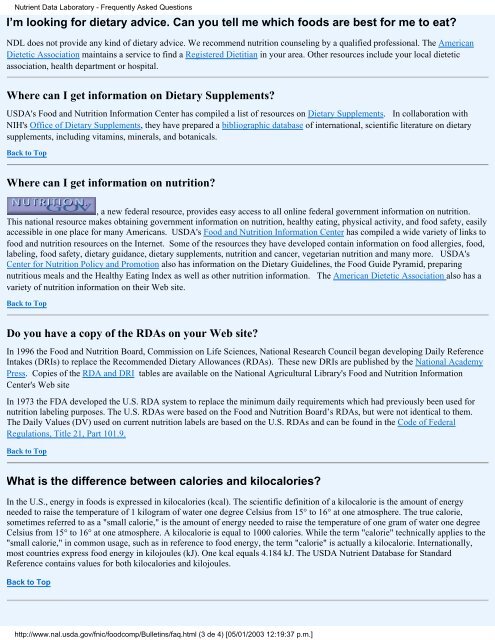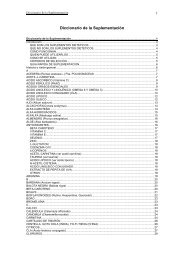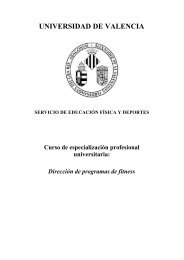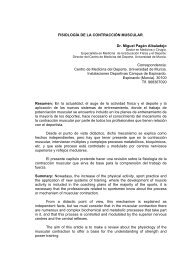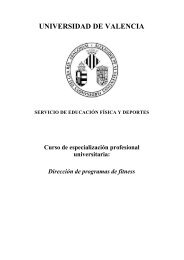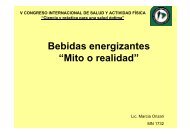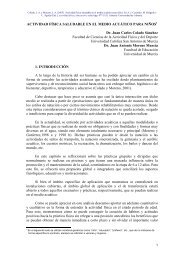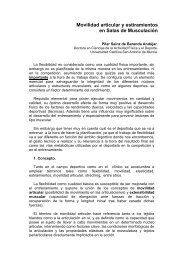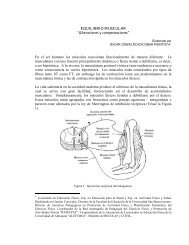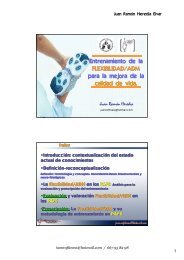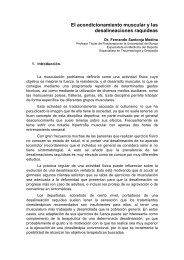Consumer.es ::: Salud y Alimentación - Felipe Isidro Donate
Consumer.es ::: Salud y Alimentación - Felipe Isidro Donate
Consumer.es ::: Salud y Alimentación - Felipe Isidro Donate
You also want an ePaper? Increase the reach of your titles
YUMPU automatically turns print PDFs into web optimized ePapers that Google loves.
Nutrient Data Laboratory - Frequently Asked Qu<strong>es</strong>tions<br />
I’m looking for dietary advice. Can you tell me which foods are b<strong>es</strong>t for me to eat?<br />
NDL do<strong>es</strong> not provide any kind of dietary advice. We recommend nutrition counseling by a qualified prof<strong>es</strong>sional. The American<br />
Dietetic Association maintains a service to find a Registered Dietitian in your area. Other r<strong>es</strong>ourc<strong>es</strong> include your local dietetic<br />
association, health department or hospital.<br />
Where can I get information on Dietary Supplements?<br />
USDA's Food and Nutrition Information Center has compiled a list of r<strong>es</strong>ourc<strong>es</strong> on Dietary Supplements. In collaboration with<br />
NIH's Office of Dietary Supplements, they have prepared a bibliographic database of international, scientific literature on dietary<br />
supplements, including vitamins, minerals, and botanicals.<br />
Back to Top<br />
Where can I get information on nutrition?<br />
, a new federal r<strong>es</strong>ource, provid<strong>es</strong> easy acc<strong>es</strong>s to all online federal government information on nutrition.<br />
This national r<strong>es</strong>ource mak<strong>es</strong> obtaining government information on nutrition, healthy eating, physical activity, and food safety, easily<br />
acc<strong>es</strong>sible in one place for many Americans. USDA's Food and Nutrition Information Center has compiled a wide variety of links to<br />
food and nutrition r<strong>es</strong>ourc<strong>es</strong> on the Internet. Some of the r<strong>es</strong>ourc<strong>es</strong> they have developed contain information on food allergi<strong>es</strong>, food,<br />
labeling, food safety, dietary guidance, dietary supplements, nutrition and cancer, vegetarian nutrition and many more. USDA's<br />
Center for Nutrition Policy and Promotion also has information on the Dietary Guidelin<strong>es</strong>, the Food Guide Pyramid, preparing<br />
nutritious meals and the Healthy Eating Index as well as other nutrition information. The American Dietetic Association also has a<br />
variety of nutrition information on their Web site.<br />
Back to Top<br />
Do you have a copy of the RDAs on your Web site?<br />
In 1996 the Food and Nutrition Board, Commission on Life Scienc<strong>es</strong>, National R<strong>es</strong>earch Council began developing Daily Reference<br />
Intak<strong>es</strong> (DRIs) to replace the Recommended Dietary Allowanc<strong>es</strong> (RDAs). Th<strong>es</strong>e new DRIs are published by the National Academy<br />
Pr<strong>es</strong>s. Copi<strong>es</strong> of the RDA and DRI tabl<strong>es</strong> are available on the National Agricultural Library's Food and Nutrition Information<br />
Center's Web site<br />
In 1973 the FDA developed the U.S. RDA system to replace the minimum daily requirements which had previously been used for<br />
nutrition labeling purpos<strong>es</strong>. The U.S. RDAs were based on the Food and Nutrition Board’s RDAs, but were not identical to them.<br />
The Daily Valu<strong>es</strong> (DV) used on current nutrition labels are based on the U.S. RDAs and can be found in the Code of Federal<br />
Regulations, Title 21, Part 101.9.<br />
Back to Top<br />
What is the difference between calori<strong>es</strong> and kilocalori<strong>es</strong>?<br />
In the U.S., energy in foods is expr<strong>es</strong>sed in kilocalori<strong>es</strong> (kcal). The scientific definition of a kilocalorie is the amount of energy<br />
needed to raise the temperature of 1 kilogram of water one degree Celsius from 15° to 16° at one atmosphere. The true calorie,<br />
sometim<strong>es</strong> referred to as a "small calorie," is the amount of energy needed to raise the temperature of one gram of water one degree<br />
Celsius from 15° to 16° at one atmosphere. A kilocalorie is equal to 1000 calori<strong>es</strong>. While the term "calorie" technically appli<strong>es</strong> to the<br />
"small calorie," in common usage, such as in reference to food energy, the term "calorie" is actually a kilocalorie. Internationally,<br />
most countri<strong>es</strong> expr<strong>es</strong>s food energy in kilojoul<strong>es</strong> (kJ). One kcal equals 4.184 kJ. The USDA Nutrient Database for Standard<br />
Reference contains valu<strong>es</strong> for both kilocalori<strong>es</strong> and kilojoul<strong>es</strong>.<br />
Back to Top<br />
http://www.nal.usda.gov/fnic/foodcomp/Bulletins/faq.html (3 de 4) [05/01/2003 12:19:37 p.m.]


